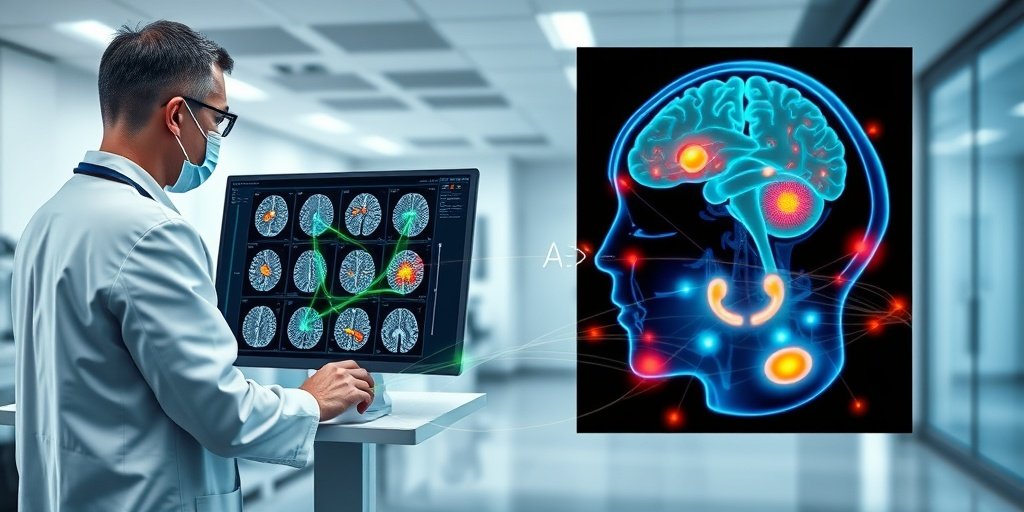⚡ Quick Summary
This study introduces a deep learning framework that enhances grading accuracy in high-grade gliomas through modality imputation and subregion segmentation. The results indicate a significant improvement in diagnostic accuracy, with the AUC increasing from 0.718 to 0.913 when utilizing the proposed models.
🔍 Key Details
- 📊 Dataset: 1,251 patients from BraTS2021 and 181 clinical cases
- 🧩 Features used: MRI modalities including T1, T1ce, and T2
- ⚙️ Technology: PatchGAN-based modality imputation network with Aggregated Residual Transformer (ART) and U-Net for segmentation
- 🏆 Performance: DSC of 0.878 and HD95 of 19.491 for segmentation
🔑 Key Takeaways
- 🧠 Deep learning can significantly improve the grading of high-grade gliomas.
- 📈 AUC increased from 0.718 to 0.913, indicating enhanced diagnostic accuracy.
- 🔍 The ET region showed the highest segmentation accuracy with a DSC of 0.877.
- 💡 Modality imputation was most effective between T1 to T1ce and T1ce to T2.
- 📊 Statistical analysis confirmed the significance of the results (p < 0.001).
- 👩⚕️ Clinical validation involved senior radiologists assessing the model’s performance.
- 🌟 The framework aids radiologists in making more informed clinical decisions.
- 🗓️ Study period: Data collected from April 2013 to June 2018.

📚 Background
High-grade gliomas are among the most aggressive brain tumors, presenting significant challenges in accurate grading and treatment planning. Traditional imaging techniques often fall short in providing the necessary detail for precise diagnosis. The integration of deep learning technologies into medical imaging offers a promising avenue for enhancing diagnostic accuracy and improving patient outcomes.
🗒️ Study
This study conducted a retrospective analysis using data from 1,251 patients in the BraTS2021 dataset and an additional 181 clinical cases from a medical center. The researchers developed a novel framework that combines modality imputation and subregion segmentation to improve the grading of high-grade gliomas. The methodology involved a PatchGAN-based network integrated with an Aggregated Residual Transformer (ART) module and a U-Net variant for effective segmentation.
📈 Results
The study achieved an overall DSC of 0.878 and an HD95 of 19.491 for segmentation performance. Notably, the enhancing tumor (ET) region exhibited the highest accuracy with a DSC of 0.877 and an HD95 of 12.149. The clinical validation demonstrated a remarkable improvement in grading accuracy, with the AUC rising from 0.718 to 0.913 when the combined models were employed.
🌍 Impact and Implications
The findings from this study have significant implications for the field of neuro-oncology. By leveraging deep learning for modality imputation and segmentation, clinicians can achieve more accurate grading of high-grade gliomas, ultimately leading to better-informed treatment decisions. This advancement not only enhances diagnostic capabilities but also holds the potential to improve patient outcomes in clinical settings.
🔮 Conclusion
This research highlights the transformative potential of deep learning technologies in the realm of medical imaging, particularly for high-grade glioma grading. The proposed framework demonstrates a clear pathway toward improving diagnostic accuracy, which is crucial for effective patient management. Continued exploration and validation of such technologies are essential for advancing clinical practices in neuro-oncology.
💬 Your comments
What are your thoughts on the integration of deep learning in medical imaging? We invite you to share your insights and engage in a discussion! 💬 Leave your comments below or connect with us on social media:
Deep learning-driven modality imputation and subregion segmentation to enhance high-grade glioma grading.
Abstract
PURPOSE: This study aims to develop a deep learning framework that leverages modality imputation and subregion segmentation to improve grading accuracy in high-grade gliomas.
MATERIALS AND METHODS: A retrospective analysis was conducted using data from 1,251 patients in the BraTS2021 dataset as the main cohort and 181 clinical cases collected from a medical center between April 2013 and June 2018 (51 years ± 17; 104 males) as the external test set. We propose a PatchGAN-based modality imputation network with an Aggregated Residual Transformer (ART) module combining Transformer self-attention and CNN feature extraction via residual links, paired with a U-Net variant for segmentation. Generative accuracy used PSNR and SSIM for modality conversions, while segmentation performance was measured with DSC and HD95 across necrotic core (NCR), edema (ED), and enhancing tumor (ET) regions. Senior radiologists conducted a comprehensive Likert-based assessment, with diagnostic accuracy evaluated by AUC. Statistical analysis was performed using the Wilcoxon signed-rank test and the DeLong test.
RESULTS: The best source-target modality pairs for imputation were T1 to T1ce and T1ce to T2 (p < 0.001). In subregion segmentation, the overall DSC was 0.878 and HD95 was 19.491, with the ET region showing the highest segmentation accuracy (DSC: 0.877, HD95: 12.149). Clinical validation revealed an improvement in grading accuracy by the senior radiologist, with the AUC increasing from 0.718 to 0.913 (P < 0.001) when using the combined imputation and segmentation models.
CONCLUSION: The proposed deep learning framework improves high-grade glioma grading by modality imputation and segmentation, aiding the senior radiologist and offering potential to advance clinical decision-making.
Author: [‘Yu J’, ‘Liu Q’, ‘Xu C’, ‘Zhou Q’, ‘Xu J’, ‘Zhu L’, ‘Chen C’, ‘Zhou Y’, ‘Xiao B’, ‘Zheng L’, ‘Zhou X’, ‘Zhang F’, ‘Ye Y’, ‘Mi H’, ‘Zhang D’, ‘Yang L’, ‘Wu Z’, ‘Wang J’, ‘Chen M’, ‘Zhou Z’, ‘Wang H’, ‘Wang VY’, ‘Wang E’, ‘Xu D’]
Journal: BMC Med Inform Decis Mak
Citation: Yu J, et al. Deep learning-driven modality imputation and subregion segmentation to enhance high-grade glioma grading. Deep learning-driven modality imputation and subregion segmentation to enhance high-grade glioma grading. 2025; 25:200. doi: 10.1186/s12911-025-03029-0